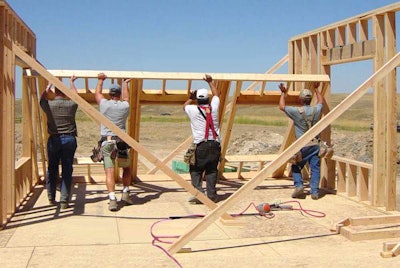 A new study says carpenters are the most difficult position for construction firms to fill.
A new study says carpenters are the most difficult position for construction firms to fill.
Seventy percent of construction contractors in the United State report having a hard time finding hourly craft workers, and more than 35 percent are having a hard time hiring salaried office and field employees, according to a study released August 29 by the Association of General Contractors of America and Autodesk.
The latest figure is up slightly from the AGC’s 2016 survey which found that 69 percent of responding firms were having a hard time filling positions. The 2017 figure is still well below 2015’s 79 percent.
However, the destruction caused by Hurricane Harvey in the last week will likely cause even more consternation to contractors in and around Texas.
AGC chief economist Ken Simonson says the flooding and damage brought by the storm will add to the worker shortage in Texas and in surrounding states, as it will divert workers from other projects.
“A lot of projects will be delayed in the state,” he said during a conference call to discuss the survey results.
According to the 2017 survey, the five most difficult hourly positions to fill are for carpenters (58 percent had difficulty hiring), bricklayers (53%), electricians (53%), concrete workers (51%) and plumbers (50%).
For salaried employees, project managers and supervisors (48%), estimating personnel (32%) and engineers (28%) are the most difficult to find, according to the survey, which had 1,600 respondents.
Half of the respondents said they had increased base pay for hourly workers in the past year to try to attract and keep employees, and 43 percent had raised salaries. Thirty-four percent said they had given bonuses and incentives to salaried employees in the past year, and 24 percent had done so for hourly workers.
The region facing the most difficulty in hiring hourly craft workers was the West at 75 percent. Next came the Midwest at 72 percent, the South at 70 percent and the Northeast at 63 percent.
The region facing the most difficulty hiring salaried field and office workers was the Northeast at over 43 percent, followed by the West at 41 percent, the Midwest at 38 percent and the South at 27 percent.
AGC officials said the shortage will lead to short-term problems and long-term solutions.
“In the short-term, fewer firms will be able to bid on construction projects if they are concerned they will not have enough workers to meet demand,” said Stephen Sandherr, CEO of AGC. “Over the long-term, either construction firms will find a way to do more with fewer workers or public officials will take steps to encourage more people to pursue careers in construction.”
Despite the difficulty in finding workers, most firms responded that they planned to expand and hire more employees over the next 12 months: 69 percent said they would be hiring hourly craft workers; 51 percent, field salary personnel; 43 percent, salaried office personnel; and 33 percent, hourly office personnel.
Local training programs to prepare workers got low marks, with 74 percent of respondents rating them as poor or fair.
During Tuesday’s conference call to discuss the survey, various officials discussed the need to seek military veterans, women and minorities, and for contractors to become more involved in advocating for better vocational programs in the high schools to attract young workers, who can make substantially more than in retail and other service jobs.
Most respondents said they had made a concerted effort to recruit veterans (79%), women (70%) and African Americans (64%).
One of the main reasons for the shortage came when the recession wiped out one-third of the construction workforce, leaving many to find other careers or leave the workforce for good. Baby boomers’ retiring en masse over the coming years is exacerbating the problem, leaving fewer highly trained workers.












